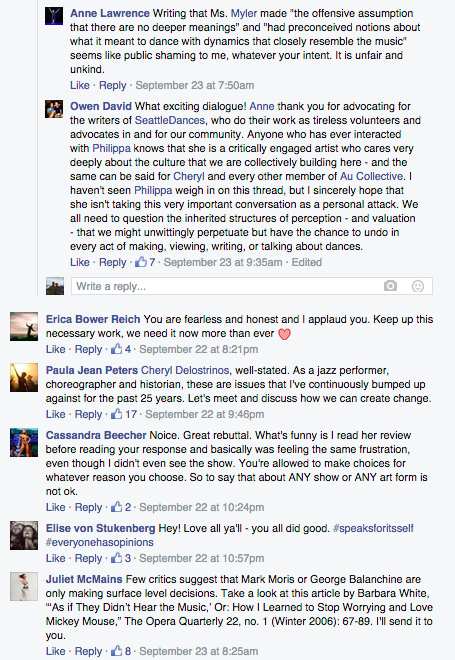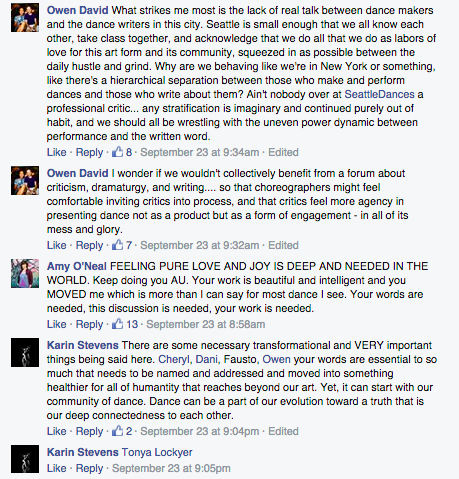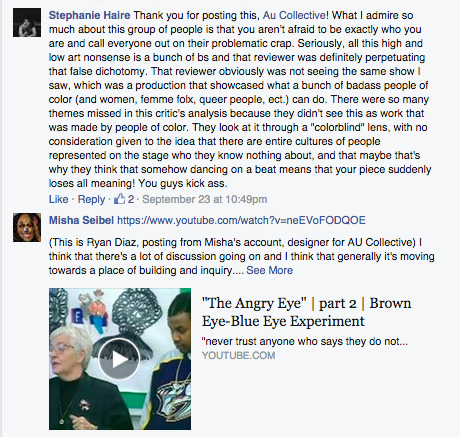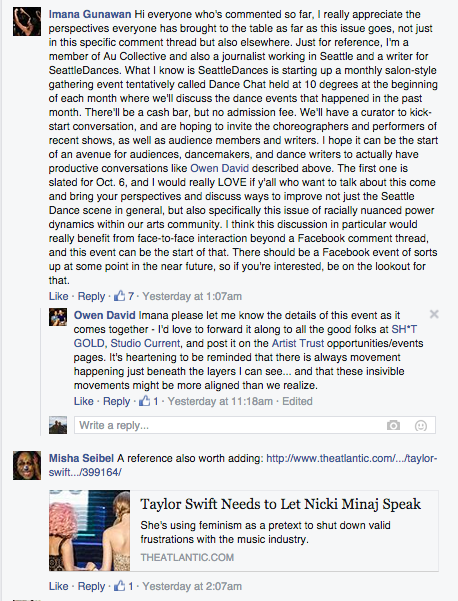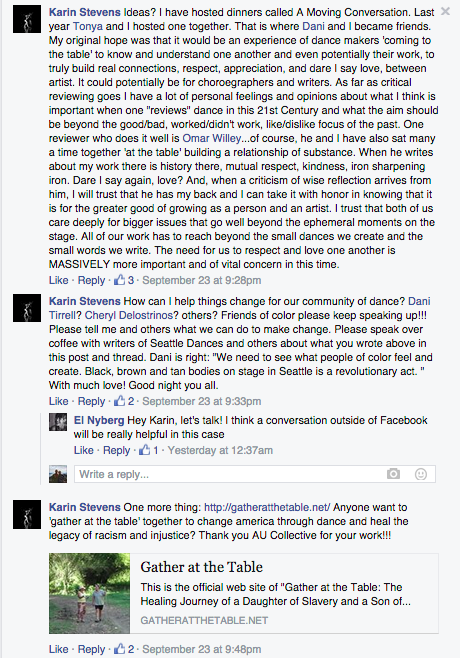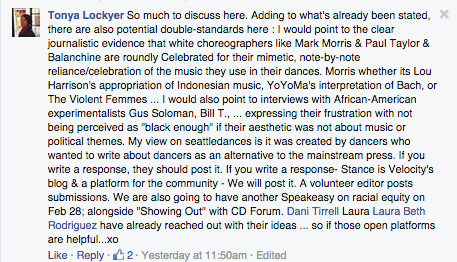I’d like to share a conversation that has been happening via Facebook in Seattle, re: the recent AU show and the corresponding Seattle Dances review.
Posted by Cheryl Delostrinos:
From Au Collective:
Hi everyone, we want to share a review that was published about our show we had at 12th Avenue Arts. The only reason we’re sharing this with you is because we need to address a specific issue that we know extends beyond our show.
“the structure of the choreography, along with changes in the lighting’s brightness and design, reflected the musical dynamic too closely to suggest more than surface level decision making.”
We have an issue with how the reviewer writes about our relationship to our music. The reviewer operates with the assumption that dancing to the dynamics of the music make the movement, or the piece in general, void of artistic integrity. Throughout our show, and within our general aesthetic, there are conscious and intentional references to hip-hop and other styles of dance that strongly relate to the music. The fact that we move to the music and use contemporary pop songs or an “electronic sound score,” are choices we made fully conscious of what we were presenting and how these specific choices read in the mainstream. The review follows the same hierarchy of aesthetics that we see in the greater arts community, and it’s not a new critique. It’s the same critique that’s been used time and time again to invalidate or undermine dance forms outside of the traditional, Euro-centric forms like ballet and modern dance. Art rooted in communities of color, like hip hop for example, is often deemed as less artistic and just ‘fun’ and ‘devoid of much meaning or significance’, while art that has a greater white lineage, or has been appropriated by the white mainstream, is often considered more artistic and valid. Often it is white tastemakers and audiences that get to decide what’s more valuable. This is the issue with bringing our perspectives to the stage.
As artists of color, we are not looked at through the same lens as white artists. It was not assumed we did indeed create dance with more than “surface level decision making” and that at times, closely resembling the dynamics of the music were choices we made very much on purpose. I’m certain that reviewer feels she doesn’t view art through this lens, but I assure you she does and most of us do as well. Most of us do because that is what we have been taught as a society. It’s not as simple as disagreeing on whether dance that closely resembles musical dynamics is good or not. She even said she liked some of the dances. The issue lies in the offensive assumption that there are no deeper meanings and that we created dance without searching for any, simply because the reviewer had preconceived notions about what it meant to dance with dynamics that closely resemble the music. With that said, it is valid to make dance that is just movement, it is also valid to make dance that is solely focused on the conceptual, and it’s valid to create outside of this binary as well. It is not valid to not have the freedom to choose either of these options or anything in between.
And here is the discussion that followed:
Woah, that’s a lot to unpack. I did not chime in because I find the medium of Facebook discussions to be…tedious…and I also think it cultivates a kind of opinion popularity contest that does not create a solid foundation for productive discussions. That being said, I’m really glad Cheryl Delostrinos posted this on Facebook because I think it is an issue that needs addressing and the more people know the better.
More than the quote from Cheryl above, this statement from the article in question stuck out to me:
“Delostrinos’ choices in hip costuming, electronic sound score, and unaffected performativity suggested that the audience look not to deeper meanings, but rather enjoy the movement as an offering to be taken at face value.”
It leads me to ask, why would hip costuming, electronic score, or unaffected performativity suggest that the audience not look for deeper meanings? I don’t understand that logic. I saw the show myself, and while I several of the pieces did not strike me as ultra-deep, it was more because of their light subject matter and lack of tension that they read that way. I did not find the crafting lazy. I do not think that a lack of depth and a lack of decision making are connected. Some pieces are about falling in love and being happy. And thank god for that. Other pieces of the evening, like Closer, the duet between Cheryl and Fausto Rivera, two., the duet between El Nyberg and Lorraine Laou, and Randy Ford’s Freedom is Mine, I thought were incredibly deep. But I also want to look at this work within the context of what AU’s stated goals were for this concert. They were aiming to make a show that bridged communities, that made modern dance accessible to those outside of the often insular scene, to remove some of the elitist, classist, and racist hierarchies that pervade who and what is art, and who is permitted to partake. It seems the priority of AU is not their depth, but their width.
I will also admit that though I appreciated these works, none resonated particularly with me personally. They weren’t my favorite aesthetic. They didn’t approach the subjects that I’m perpetually interested in. I didn’t find myself identifying with the dances on a deeper level. I might guess that the author of the article, Philippa Myler (like me, highly educated in dance and white) felt similarly. And perhaps its because these dances are not catered to us. And why should they be? So much is already.
As a reviewer (and for the publication in question) I keep returning to the question of why write critical reviews? There are a number of reasons but the one I keep coming back to is the idea of creating dialogue, and that is exactly what has happened here. It is not easy to post a defense of your work without coming off defensive, but I believe Cheryl has done so gracefully and extends her criticism beyond the scope of this article to address systems of value and white aesthetics that shape what is taken seriously in the art world…and what isn’t. It makes me ask myself, how integrated are these values to the point that we can’t see them? Once Cheryl had made the point it seemed obvious, but would have I noticed had I read the review first? How has my education and my tastes, been influenced by a perceived value of white aesthetics? Have I ever written a review that criticized a dance piece from a similar point of view? Had an opinion that I explained based on a principal I was taught and assumed to be true? I haven’t gone back through my cannon of work, but it seems very very likely.
One problem with writing from the 3rd person perspective (Seattle Dances style) is it encourages you to write your personal aesthetic as objective truth, even when you know its not. I also know as a reviewer, especially one who is volunteering, that sometimes it doesn’t work out. You have very little time. Rarely is your review a masterpiece. Sometimes you are not proud of it. Sometimes you even half-ass it because life. Sometimes you make mistakes. And then you have to have the guts to put it out there for all to read. That’s not easy. It isn’t self-serving. I have compassion for that.
I also understand what it’s like to receive a review that’s based on bullshit. Even a positive one. Like Omar Willey’s manifesto on the age of the choreographer in 2013’s BOOST review. Sorry Omar, I respect you, you even gave us some great feedback, but the premise of the whole piece was garbage. BUT I learned from that experience that I need to back up the opinions I have (and probably not with biographical data that I find through googling someone’s birthday). I think I’m a better writer now for that experience. I understand this is not a perfect alignment to the present situation, since I don’t experience the burden of centuries of oppression for being young, but my take-away is that from this experience I hope that I, and the other writers at Seattle Dances, can add to our collective consciousness and write better.


